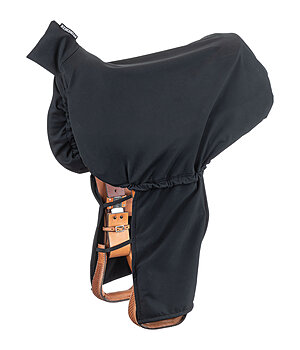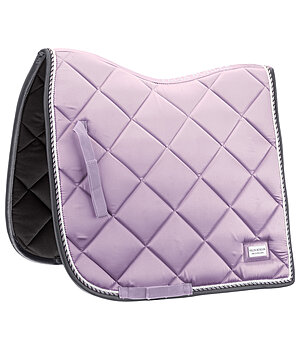Saddle care: How to correctly care for your horse’s saddle
Saddle care may not be a favourite activity for all riders when it comes to their favourite sport. However, saddle care is a necessity, as the safety of both rider and horse depends on it. At the same time, a well-maintained and shiny saddle contributes to aesthetics, especially at competitions. In this guide, you can read why you should make saddle care a fixed date in your diary and what tricks you can use to turn faded saddles back into high-shine.

Why saddle care is so important
If you were to ask riders whether they prefer a saddle that is worn and discoloured or one that is as good as new and polished to a high gloss, many riders would certainly choose the polished saddle. The fact is that a well-maintained saddle looks nicer and also ensures a tidy appearance at competitions. But there are even more points in favour of regular and intensive saddle care. The correct care products keeps the saddle leather supple, which is comfortable for horse and rider to wear and sit on. Supple leather is also more resistant and robust than brittle and dry leather. This is an important factor when it comes to safety. When riding, the equipment is exposed to weather and environmental influences such as dirt, moisture and horse sweat. If it is not cleaned and subsequently cared for, the material can be damaged and lose its resistance. In the worst case, it can even tear! To prevent dangerous riding accidents caused by the material giving way, you should regularly give your saddle a thorough treatment.

Saddles with a smooth finish are also coated with a protective layer that repels dirt and water. This protects the saddle even more.
In addition to the safety aspect, value retention also plays a role. A saddle is usually an expensive investment that you want to use not just for a few years, but possibly even decades. Even if the saddle is to be sold again after a few years, it has a higher value if it is properly maintained. Proper saddle care helps to maintain the value of the saddle.
Caring for your saddle is therefore about much more than aesthetics, which is why you should consider the correct approach.
5 steps to a well-maintained saddle
The saddle itself is cleaned relatively quickly, so it doesn’t take much time. However, you should allow sufficient drying time so that excess care products do not stick to the breeches and the products have time to penetrate deep into the leather and do their work.
1. Preparation
The first step towards a well-maintained saddle is to place it on a saddle stand or, if not available, on a non-slip surface and dismantle it. Remove the stirrups, stirrup leathers and girth. It’s easier to get into all the corners if you clean the parts individually. In the next preparation step, prepare the items you need for leather care. You will need
- Saddle soap
- Damp sponge
- Soft, dry towel and a microfibre cloth
- Leather oil or leather balm
- If you are feeling lazy: All-in-one leather care
- Possibly leather blacking agent

2. Deep cleaning with saddle soap

Firstly, the saddle must be cleaned of all types of dirt. Depending on how dirty the saddle is, this step may be more or less intensive. Leather is a natural product that „breathes“, i.e. expands and contracts with temperature fluctuations. Therefore, horse sweat and dust can seep deep into the pores of a heavily soiled saddle, which ultimately damages the leather and leads to discolouration.
Saddle soap is used to open the pores. Use a moistened sponge to pick up some of the leather soap and rub it into the leather with gentle pressure. Do not press too hard so as not to roughen the leather. It is better to go over the dirty saddle gently in several rounds than once with heavy pressure.
Don’t forget to clean and care for the underside of the saddle flaps too. Horse sweat and dirt can also get into the pores of the leather here.
Mouldy leather?
If the surface of your saddle is mouldy, use vinegar before the saddle soap to kill the mould spores. Only then can you use the saddle soap.
3. Drying
Before continuing with care, the saddle should be thoroughly dry. Even if waiting can be annoying, the saddle should not be left in the sun or on a radiator! Heat dries out the leather and makes it brittle.
4. Treatment
Now comes the actual care. Depending on the type of leather, there are various care products available. Most saddles are made of smooth leather, for which a leather balm or leather oil is suitable. They nourish the leather deep into the pores and keep it supple. Take care not to apply leather balm and leather oil too thickly. Use them sparingly, otherwise the material will swell and expand. Give the leather care product a short time to soak in after the first application. You can then rub it in thoroughly with a soft cloth.
5. Polishing
To avoid getting into the saddle and ending up with oily or greasy breeches, it is best to leave the saddle to dry overnight. The next day, you can polish your saddle to a high shine with a microfibre cloth. Caution: When polishing, do not polish the seat. Excessive polishing of the seat will make the surface slippery, which means you will no longer have any grip and will slide back and forth when riding. It is best to leave your saddle to dry for a day or overnight before using it again.

Further information on leather care
Not all leather is the same. When it comes to saddle care, it particularly depends on whether you have a saddle made of smooth leather, suede or synthetic leather. So if you would like to find out more about leather care for saddles, bridles and riding boots: We have written two complete guides on leather care and footwear care.
How often a saddle should be maintained depends on the intensity and frequency of use, the type of leather and external influences. As a rough guide, the saddle should be treated twice a year, i.e. approximately every six months. It should be cleaned of coarse dirt and moisture after every ride regardless. The saddle should also be polished to a high shine a few days before a competition. Make sure that all care products and any leather blacking agent used are well absorbed so that your white competition breeches do not discolour.
10 hacks for saddle care
5 hacks for storing your saddle:
- Stirrup covers and saddle covers. The ground is muddy and sticks to your riding boots. Small stones and lumps of dirt can damage the leather of your saddle. So before you pull up and fasten the stirrups, clean them and wrap them in a soft stirrup cover. A saddle cover can also protect the saddle from dust, dirt and scratches and thus preserve the leather.

- Less is more – this does not apply to saddle pads. Saddle pads are not just an accessory, they protect the saddle leather from corrosive horse sweat. Saddle pads can quickly become soaked with sweat which is why they no longer adequately protect the saddle from perspiration. It is better to have one saddle pad too many in the tack room so that you can regularly replace it with a fresh one. You can read more about saddle pad care in the guide.
- Dehumidifiers in the tack cabinet or tack room can ensure dry conditions. Good saddle care is wasted effort if the saddle is not stored correctly and is exposed to high humidity. This can cause mould to grow on the saddle leather. A dehumidifier in combination with regular ventilation ensures ideal storage conditions.
- Soft padded saddle suspension. The usual saddle racks made of metal bars allow good ventilation of the saddle, but can leave pressure marks in the leather. If you don’t have the alternative of a wooden saddle holder, you can pad your usual saddle holder with a soft, dry towel. Ideally, the saddle panels should hang freely so that they are not deformed.
- Hang the saddle pad and saddle separately. The moisture from the sweaty saddle pad can cause the saddle to become mouldy. It is best to hang the damp saddle pad separately with the underside facing upwards so that it can dry and air out.
5 hacks for easier saddle care
- Sock or hand flannel to slip your hand into. Does the cloth or sponge always slip out of your hand when you want to reach the furthest corners of the saddle? The problem is solved with a sock or hand flannel. Simply slip your hand into it and you can spread the leather care product into every nook and cranny.
- Shoe polish for faded saddles. The more intensively and longer a saddle is used, the more it is exposed not only to friction on the riding boots, but also to sunlight. This can cause the leather to fade and lose its saturated colour. On the one hand, a saddler can re-colour the saddle with leather dye. On the other hand, you can also help yourself with a little shoe polish in the right colour. A great deal does not help much, but a little maintains and colours well. It is better to use a pea-sized dab of colour first and then re-dye if necessary. After a short exposure time, you can massage the colour in with a soft cloth and remove any excess.
Important: Leave the dye to soak in for a day so that there is no residue on the breeches. You should not dye the areas directly on the horse or the saddle girth, as otherwise the horse will also be dyed. - Soft sponge instead of a towel. Scratches on saddle leather are more common than you think. Therefore, only use soft materials to care for your saddle. You should also regularly clean the sponge with water or replace it to prevent dirt particles from rubbing against the leather and damaging it.
- Blow-dry the saddle. Leather is a natural product with pores that expand and contract with heat and cold. To allow the leather care to penetrate better, you can blow-dry your saddle at a slight distance, warming the leather and thus opening the pores. This helps the leather care product to penetrate deep into the saddle leather. Remember that you should only heat the saddle slightly and not overheat it. Excessive heat can damage the leather.
- Alternative to leather care products: Do you need to take care of your leather quickly and have forgotten to buy leather care products? Then some body lotion or cooking oil can temporarily do the job. However, as these are not designed for leather care, you should only use them for a short time and in very small quantities.

















